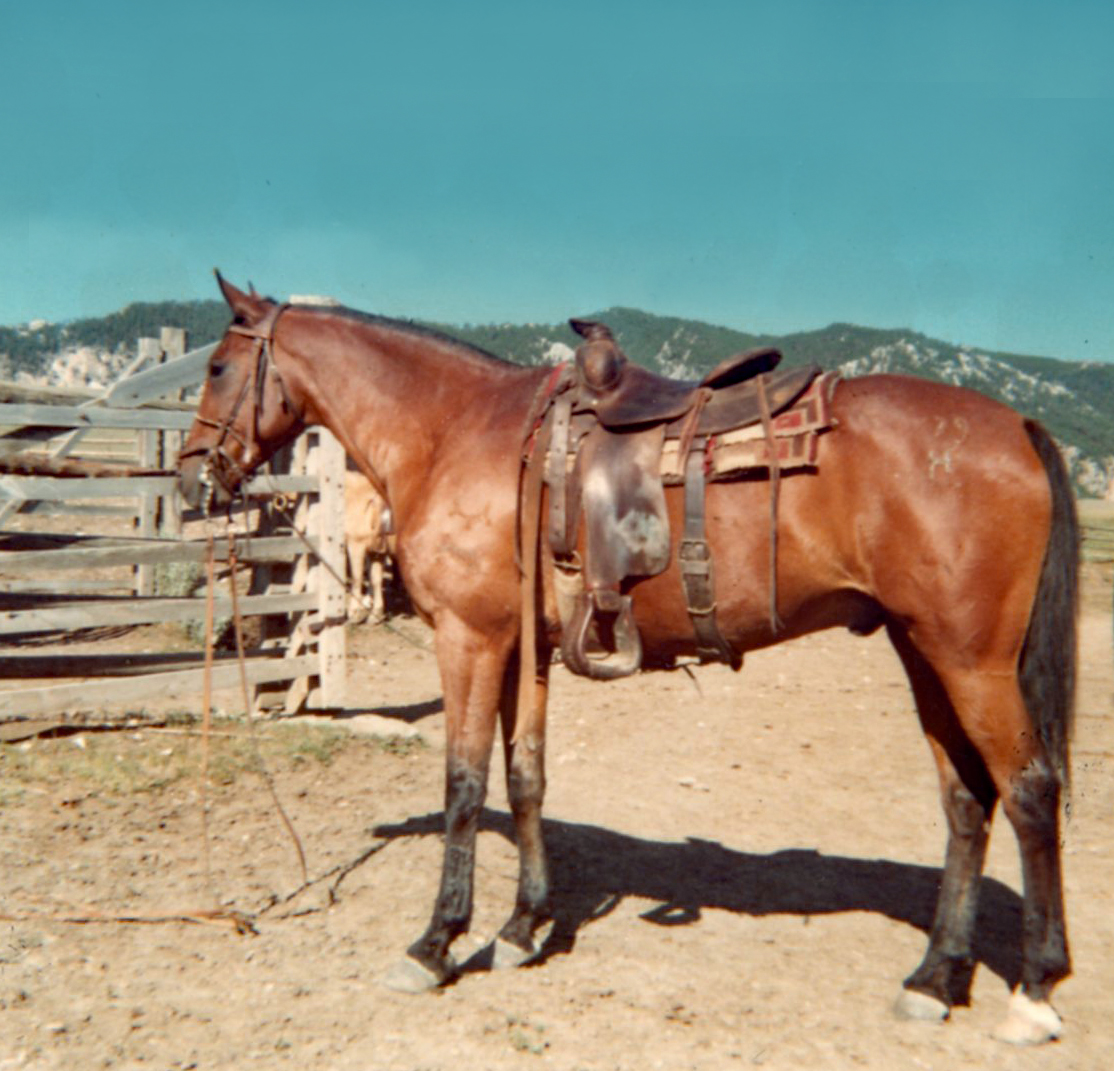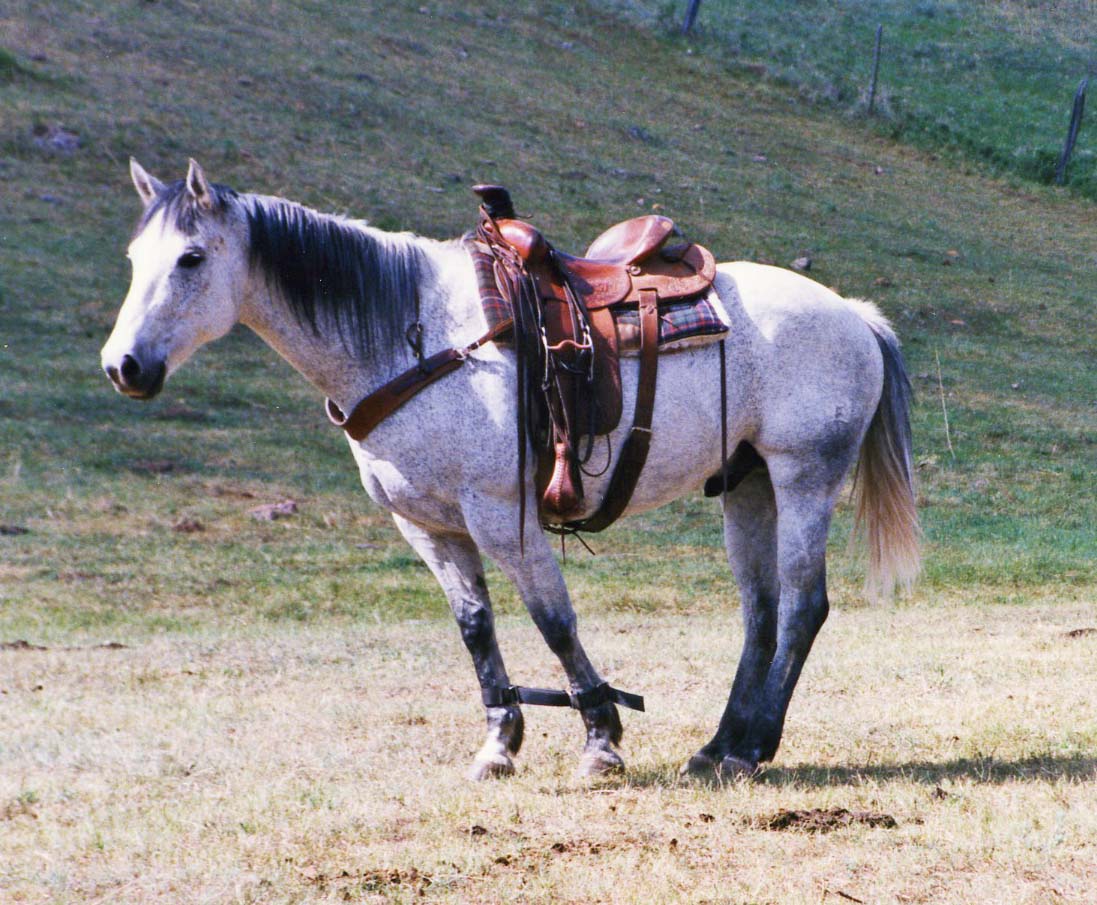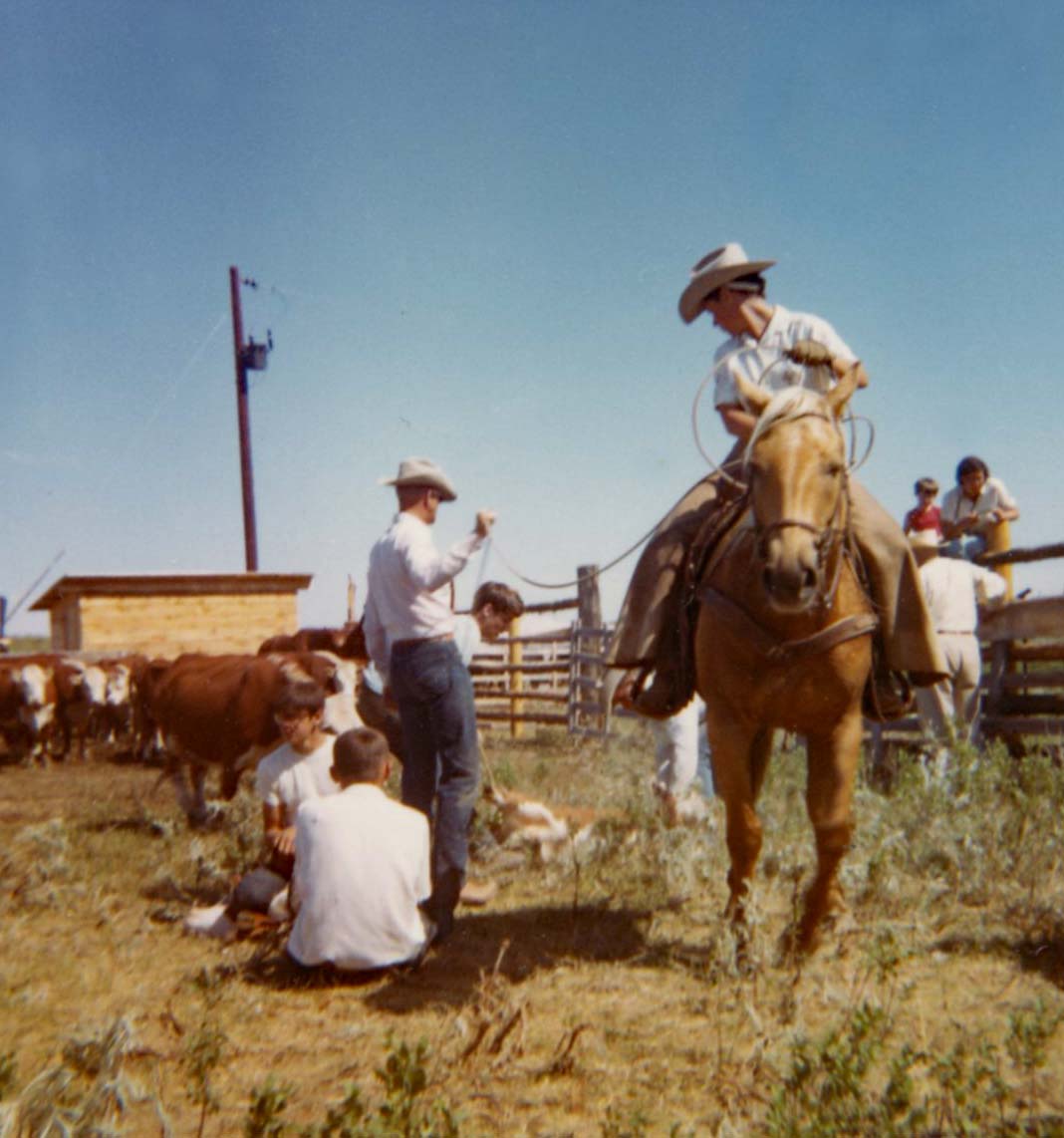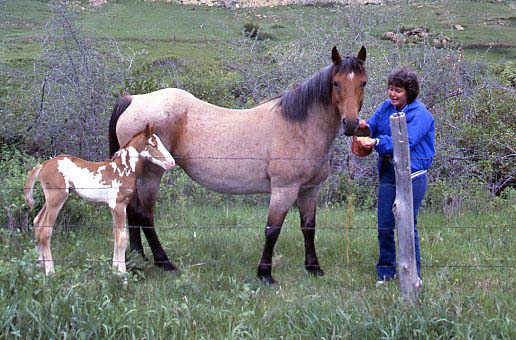What color is your horse?
Nov 10, 2022 by Tempe Javitz
Cowboy Jargon: Color Does Not Make The Breed.
Albino: An Albino horse has pink skin and a pure white coat. Albinos
are born white. They have blue or brown eyes, not pink, thus they are
not true biological albinos.
Appaloosa: Bred by the Nez Perce’ tribe, these horses have distinctive
dark spots on the rump and back. An Appaloosa also has mottled markings
on its genitals, lips, and nose. Other interesting characteristics include
striped hooves and large eyes with surrounding white sclera.
The Appaloosa is, on average, 14.2 to 16 hands high. A hand is a
measurement of 4 inches, commonly used in measuring a horse’s height.
There are many distinctive photos at https://www.appaloosa.com
Bay: A bay horse is characterized by a reddish-brown or brown body
color with a black mane, tail, ear edges, and lower legs. Bay
is one of the most common coat colors in many horse breeds.

A bay horse named “Holy Smoke”,
HF Bar Dude Ranch 1966.
Black: This is easy, the horse is black all over. True black horses have
dark brown eyes, black skin, and wholly black hair coats without any areas
of reddish or brownish hair.
Blood Bay: A dark reddish-brown horse with a black mane and tail.
Brown: A brown horse with mane and tail of the same color.
Buckskin: A horse that is the color of the hide of a buck deer. Tan in
color with a black mane and tail and a black dorsal (upper back) stripe
down it’s back.
Chestnut: A horse characterized by a reddish-to-brown coat, with a mane
and tail that is the same or lighter in color than the coat. A chestnut
is characterized by the total absence of black hairs.
Dapples: Dapples are the textured, concentric rings within the coat, and
look like amazing darker circles of coat with a lighter color on the inside.
They are commonly spotted along the rumps, and sometimes bellies or necks
of some horses.

A dappled Gray with hobbles.
Dun: Usually a sandy brown or mousey gray horse with a black mane, tail
and socks. There is usually a dorsal stripe down it's back. A dun is
characterized by a lightening of the coat, with the head, lower legs, mane,
and tail undiluted. Oftentimes, a dun is also has "primitive markings"
such as a dark dorsal stripe, barring of the legs, shoulder stripes,
and "cobwebbing" on the forehead. Hence, Zebra Dun, a dun-colored horse
with stripping on its legs.
Gray: A gray horse’s coat color is characterized by the progressive
depigmentation of the hairs of the coat. Most gray horses have black skin
and dark eyes with hair that is either gray or white.
Grulla or Grullo: (GROO-yoh or GROO-yuh) A slate blue-color with a dark mane,
tail, and socks. This horse often has zebra stripes or a dorsal stripe. If
the color is more grayish in color, that horse is called a mouse dun.
Flaxen: Having blond manes and tails that are white or even silvery in
shade. Often seen on palominos and dappled grays.
Paint: A white horse with large areas of spots, either black, brown or red.
Paint is actually short for “American Paint Horse” a particular breed. Today
paint horses are registered and have to be bred from quarter horses,
thoroughbreds or other paints. Old time Westerners used paint and pinto
interchangeably.
Palomino: A palomino is a golden horse with a cream-colored or white mane
and tail and dark eyes. They are not a breed of horse.

My sister Jolly astride her palomino
roping horse named Tuck.
Piebald: A horse is called a piebald because its coat color is black mixed
with white patches. There is actually a piebald gene that causes this
coloration.
Pinto: A spotted horse. The word “pinto” is a loose term used to describe
any horse with bold white markings on its coat. Pinto is a color pattern
that can be found in horses of many different breeds.
Sorrel: Sorrel is a reddish coat color in a horse lacking any black. Many
will distinguish it from chestnut, defining sorrel as a light, coppery shade,
and chestnut as a browner shade. However, in terms of genetics there is no known
difference between sorrel and chestnut. A solid reddish-brown color is a base
color for horses and is caused by the recessive E gene.
Strawberry Roan: Roan is a white patterning coat color of intermixed white and
colored hairs in the body while the head, lower legs, mane, and tail remain
colored. Blue roans have black base coats, red and strawberry roans have chestnut
base coats, and bay roans have chestnut base coats as well, but are distinguished
by their black points.

My sister Sandra with her strawberry
roan mare and pinto colt.
Albino: An Albino horse has pink skin and a pure white coat. Albinos
are born white. They have blue or brown eyes, not pink, thus they are
not true biological albinos.
Appaloosa: Bred by the Nez Perce’ tribe, these horses have distinctive
dark spots on the rump and back. An Appaloosa also has mottled markings
on its genitals, lips, and nose. Other interesting characteristics include
striped hooves and large eyes with surrounding white sclera.
The Appaloosa is, on average, 14.2 to 16 hands high. A hand is a
measurement of 4 inches, commonly used in measuring a horse’s height.
There are many distinctive photos at https://www.appaloosa.com
Bay: A bay horse is characterized by a reddish-brown or brown body
color with a black mane, tail, ear edges, and lower legs. Bay
is one of the most common coat colors in many horse breeds.

A bay horse named “Holy Smoke”,
HF Bar Dude Ranch 1966.
Black: This is easy, the horse is black all over. True black horses have
dark brown eyes, black skin, and wholly black hair coats without any areas
of reddish or brownish hair.
Blood Bay: A dark reddish-brown horse with a black mane and tail.
Brown: A brown horse with mane and tail of the same color.
Buckskin: A horse that is the color of the hide of a buck deer. Tan in
color with a black mane and tail and a black dorsal (upper back) stripe
down it’s back.
Chestnut: A horse characterized by a reddish-to-brown coat, with a mane
and tail that is the same or lighter in color than the coat. A chestnut
is characterized by the total absence of black hairs.
Dapples: Dapples are the textured, concentric rings within the coat, and
look like amazing darker circles of coat with a lighter color on the inside.
They are commonly spotted along the rumps, and sometimes bellies or necks
of some horses.

A dappled Gray with hobbles.
Dun: Usually a sandy brown or mousey gray horse with a black mane, tail
and socks. There is usually a dorsal stripe down it's back. A dun is
characterized by a lightening of the coat, with the head, lower legs, mane,
and tail undiluted. Oftentimes, a dun is also has "primitive markings"
such as a dark dorsal stripe, barring of the legs, shoulder stripes,
and "cobwebbing" on the forehead. Hence, Zebra Dun, a dun-colored horse
with stripping on its legs.
Gray: A gray horse’s coat color is characterized by the progressive
depigmentation of the hairs of the coat. Most gray horses have black skin
and dark eyes with hair that is either gray or white.
Grulla or Grullo: (GROO-yoh or GROO-yuh) A slate blue-color with a dark mane,
tail, and socks. This horse often has zebra stripes or a dorsal stripe. If
the color is more grayish in color, that horse is called a mouse dun.
Flaxen: Having blond manes and tails that are white or even silvery in
shade. Often seen on palominos and dappled grays.
Paint: A white horse with large areas of spots, either black, brown or red.
Paint is actually short for “American Paint Horse” a particular breed. Today
paint horses are registered and have to be bred from quarter horses,
thoroughbreds or other paints. Old time Westerners used paint and pinto
interchangeably.
Palomino: A palomino is a golden horse with a cream-colored or white mane
and tail and dark eyes. They are not a breed of horse.

My sister Jolly astride her palomino
roping horse named Tuck.
Piebald: A horse is called a piebald because its coat color is black mixed
with white patches. There is actually a piebald gene that causes this
coloration.
Pinto: A spotted horse. The word “pinto” is a loose term used to describe
any horse with bold white markings on its coat. Pinto is a color pattern
that can be found in horses of many different breeds.
Sorrel: Sorrel is a reddish coat color in a horse lacking any black. Many
will distinguish it from chestnut, defining sorrel as a light, coppery shade,
and chestnut as a browner shade. However, in terms of genetics there is no known
difference between sorrel and chestnut. A solid reddish-brown color is a base
color for horses and is caused by the recessive E gene.
Strawberry Roan: Roan is a white patterning coat color of intermixed white and
colored hairs in the body while the head, lower legs, mane, and tail remain
colored. Blue roans have black base coats, red and strawberry roans have chestnut
base coats, and bay roans have chestnut base coats as well, but are distinguished
by their black points.

My sister Sandra with her strawberry
roan mare and pinto colt.
